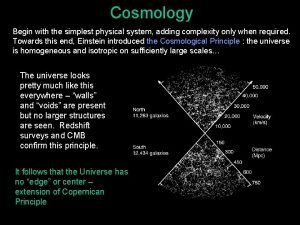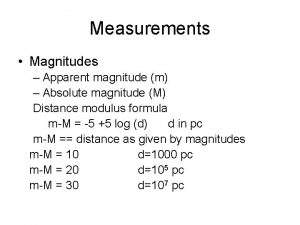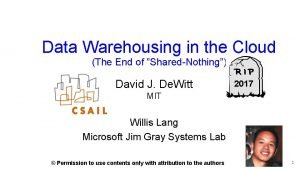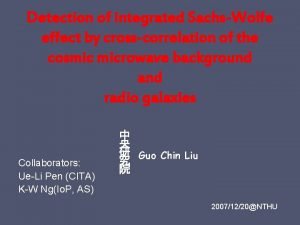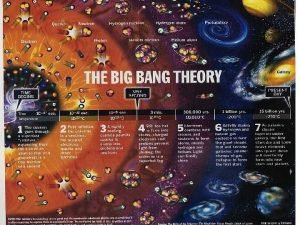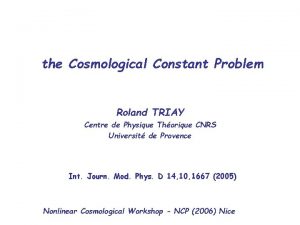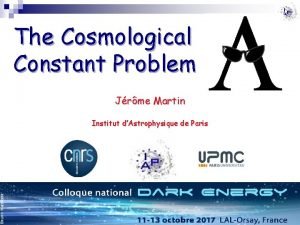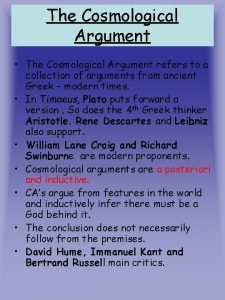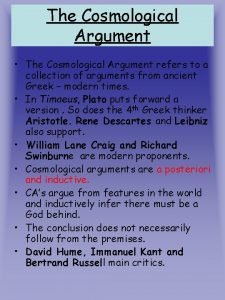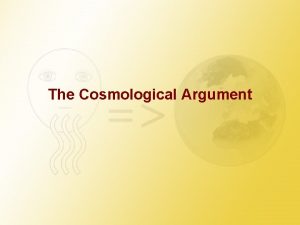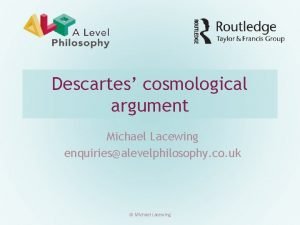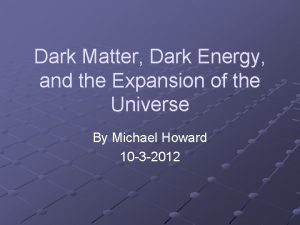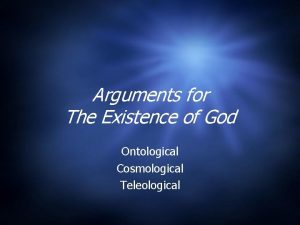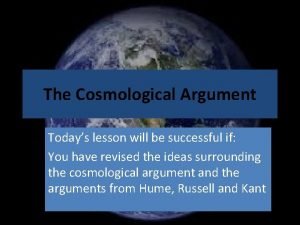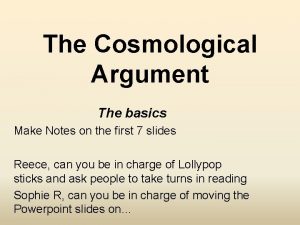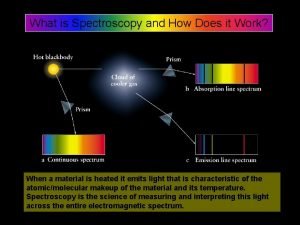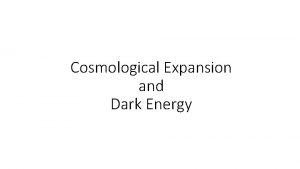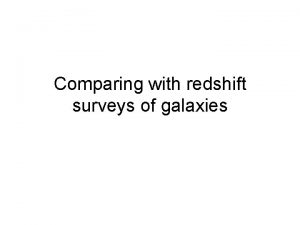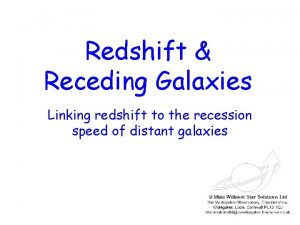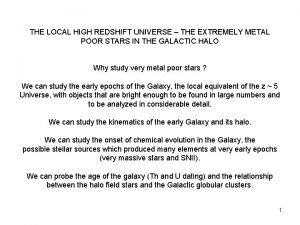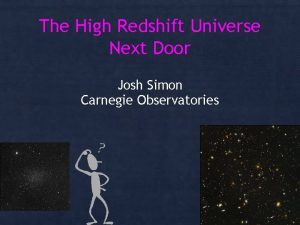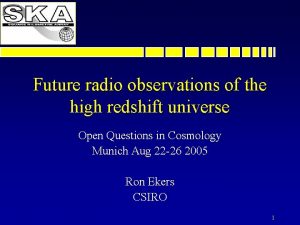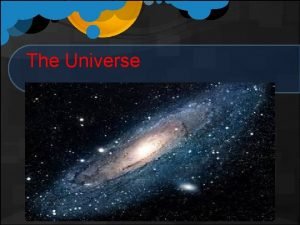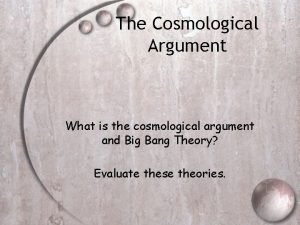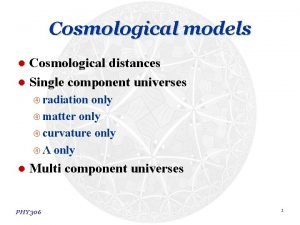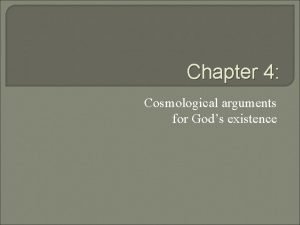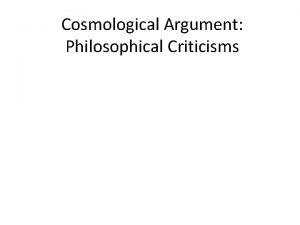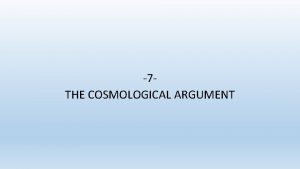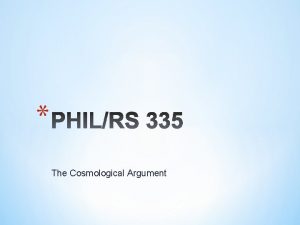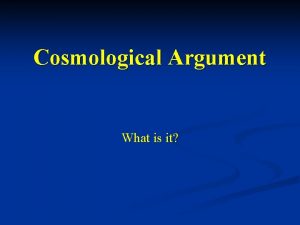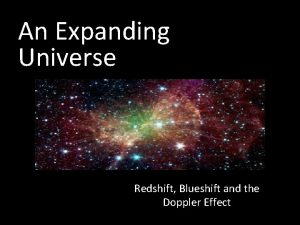COSMOLOGICAL SPECTROSCOPY OF THE HIGH REDSHIFT UNIVERSE STATUS































































- Slides: 63

COSMOLOGICAL SPECTROSCOPY OF THE HIGH REDSHIFT UNIVERSE: STATUS & PERSPECTIVES 60 comoving Mpc/h MATTEO VIEL INAF & INFN – Trieste HEIDELBERG JOINT ASTRONOMICAL COLLOQUIUM 14 t/h DECEMBER 2010

OUTLINE 1 - INTRODUCTION: THE LYMAN-a FOREST 2 - RESULTS IN TERMS OF LARGE SCALE STRUCTURE 3 - RESULTS IN TERMS OF FUNDAMENTAL PHYSICS 4 - RESULTS IN TERMS OF GALAXY/IGM INTERPLAY 5 - PERSPECTIVES

INTRO

Lyman-a absorption is the main manifestation of the IGM Tiny neutral hydrogen fraction after reionization…. But large cross-section


DATA: high resolution spectrum

THEORY: GAS in a LCDM universe 80 % of the baryons at z=3 are in the Lyman-a forest Bi & Davidsen (1997) Rauch (1998, review) Meiksin (2009, review) Bolton et al. 06 baryons as tracer of the dark matter density field d IGM ~ d DM at scales larger than the Jeans length ~ 1 com Mpc flux = exp(-t) ~ exp(-(d. IGM )1. 6 T -0. 7 )

BRIEF HISTORICAL OVERVIEW of the Lyman-a forest ‘ISOLATED’ CLOUDS NETWORK OF FILAMENTS PROBES OF THE JEANS SCALE COSMOLOGICAL PROBES

Tools to investigate the Lyman-a forest Discrete fields: statistics of lines fitted with Voigt profile examples: Doppler parameters, column density distribution functions Continuous fields: transmitted flux examples: mean flux, flux probability distribution function, flux power and bispectrum Other statistics: wavelets, pixel optical depth techniques etc. Scientific rationale and quality of data will decide the statistics to be used CAVEATS The dynamical growth is convolved with thermal state of the IGM There are systematic errors that impact more than statistical ones: Ex. Metals and continuum fitting Simplest assumptions: model the flux power as a bias times the matter power

DATA vs THEORY

DATA vs THEORY P FLUX (k, z) = bias 2 (k, z) x P MATTER (k, z)

DATA vs THEORY

FUNDAMENTAL PROPERTIES OF THE DARK MATTER: IMPACT ON CLUSTERING SDSS galaxies Abazajian 2006 DARK MATTER cutoff Depending on the scale: Hot 100 Mpc Warm Mpc Cold << 1 Mpc

Outline in collaboration with: Haehnelt, Bolton, Carswell, Kim, Springel Becker, Rauch, Lesgourgues, Boyarsky, Ruchaysky, Matarrese, Riotto, Sargent, etc. - What data we got The data sets - How we used them Theoretical framework - What we achieved Results Why Lyman-a ? Small scales High redshift Most of the baryonic mass is in this form Quasars sample 75% of the age of the universe

The data sets SDSS vs LUQAS Mc. Donald et al. 2005 Kim, MV et al. 2004 SDSS 3035 LOW RESOLUTION LOW S/N LUQAS vs 30 HIGH RESOLUTION HIGH S/N

The interpretation: full grid of sims - I SDSS power analysed by forward modelling motivated by the huge amount of data with small statistical errors CMB: Komatsu et al. (09) Galaxy P(k): Sanchez & Cole (07) + Flux Power: Mc. Donald (05) + 132 data points z=4. 2 z=2. 2 Cosmological parameters + e. g. bias + Parameters describing IGM physics

Mc. Donald et al. 05 The interpretation: full grid of sims - II Tens of thousands of models Monte Carlo Markov Chains - Cosmology - Mean flux - T=T 0 (1+d)g-1 - Reionization - Metals - Noise - Resolution - Damped Systems - Physics - UV background - Small scales

The interpretation: flux derivatives - III Independent analysis of SDSS power Both methods have drawbacks and advantages: The flux power spectrum is a smooth function of k and z 1 - Mc. Donald et al. 05 better sample the parameter space 2 - Viel & Haehnelt 06 rely on hydro simulations, but probably error bars are underestimated Flux power P F (k, z; p) = P F (k, z; p 0) + S i=1, N Best fit P F (k, z; pi) pi (pi - pi 0) 0 p=p p: astrophysical and cosmological parameters but even resolution and/or box size effects if you want to save CPU time

RESULTS POWER SPECTRUM AND NEUTRINOS

Results Lyman-a only with full grid: amplitude and slope Mc. Donald et al. 05 Croft et al. 98, 02 40% uncertainty Croft et al. 02 28% uncertainty Viel et al. 04 29% uncertainty Mc. Donald et al. 05 14% uncertainty AMPLITUDE c 2 likelihood code distributed with COSMOMC SLOPE Redshift z=3 and k=0. 009 s/km corresponding to ~7 comoving Mpc/h

Results Lyman-a only with flux derivatives: correlations Fitting SDSS data with GADGET-2 this is SDSS Ly-a only FLUX DERIVATIVES SDSS data only s 8 = 0. 91 ± 0. 07 n = 0. 97 ± 0. 04

Summary (highlights) of results 1. Competitive constraints in terms of cosmological parameters (in particular shape and curvature of the power spectrum) Lesgourgues, MV, Haehnelt, Massey (2007) JCAP 11 008 2. Tightest constraints to date on neutrino masses and running of the spectral index Seljak, Slosar, Mc. Donald JCAP (2006) 10 014 3. Tightest constraints to date on the coldness of cold dark matter MV et al. , Phys. Rev. Lett. 100 (2008) 041304

Lyman-a forest + Weak Lensing + WMAP 5 yrs Lesgourgues, MV, Haehnelt, Massey, 2007, JCAP, 8, 11 |dn/dlnk| < 0. 021 WMAP 7 yrs WMAP 7 Komatsu et al. 10 s 8 = 0. 801 ± 0. 030 ns = 0. 963 ± 0. 014 Wm= 0. 258 ± 0. 030 h = 0. 71 ± 0. 025 t= 0. 088 ± 0. 015 dn/dlnk= -0. 034 ± 0. 026 WMAP 7+BAO+SN Komatsu et al. 10 s 8 = 0. 809 ± 0. 024 ns = 0. 963 ± 0. 012 h = 0. 704 ± 0. 013 t = 0. 087 ± 0. 014 with Lyman-a factor two improvement on the running of the spectral index !

Active neutrinos –I: linear theory Lesgourgues & Pastor Phys. Rept. 2006, 429, 307 S m n = 0. 138 e. V Lyman-a forest S m n = 1. 38 e. V

Active neutrinos –II: constraints from Ly-a Seljak, Slosar, Mc. Donald, 2006, JCAP, 0610, 014 3 normal 1, 2 2 inverted 3 1 2 s limit DISFAVOURED BY LYMAN-a Tight constraints because data are marginally compatible Smn (e. V) < 0. 17 (95 %C. L. ), < 0. 19 e. V (Fogli et al. 08) r < 0. 22 (95 % C. L. ) running = -0. 015 ± 0. 012 Neff = 5. 2 (3. 2 without Ly a) CMB + SN + SDSS gal+ SDSS Ly-a Goobar et al. 06 get upper limits 2 -3 times larger forecasting see Gratton, Lewis, Efstathiou 2007

Active neutrinos – III: non linear evolution Viel, Haehnelt, Springel, 2010 JCAP, 06, 015 See also Brandbyge, Hannestad et al. 2007, 2008, 2009

RESULTS WARM DARK MATTER Or if you prefer. . How cold is cold dark matter?

Lyman-a and Warm Dark Matter - I LCDM 30 comoving Mpc/h z=3 In general k FS ~ 5 Tv/Tx (m x/1 ke. V) Mpc-1 Set by relativistic degrees of freedom at decoupling WDM 0. 5 ke. V See Colombi, Dodelson, Widrow, 1996 Colin, Avila-Reese, Valenzuela 2000 Bode, Ostriker, Turok 2001 Abazajian, Fuller, Patel 2001 Abazajian 2006 Abazajian & Koushiappas 2006 Wang & White 2007 Colin, Avila-Reese, Valenzuela 2008 Tikhonov et al. 2009 MV, Lesgourgues, Haehnelt, Matarrese, Riotto, PRD, 2005, 71, 063534

Lyman-a and Warm Dark Matter - II LCDM 1. 4 ke. V 1 ke. V 0. 7 ke. V [P (k) WDM/P (k) CDM ]1/2 0. 4 ke. V 0. 1 ke. V

Lyman-a and Warm Dark Matter - III MV, Becker, Bolton, Haehnelt, Rauch, Sargent, Phys. Rev. Lett. 100 (2008) 041304 SDSS + HIRES data (SDSS still very constraining!) Tightest constraints on mass of WDM particles to date: m WDM > 4 ke. V (early decoupled thermal relics) m sterile > 28 ke. V (standard Dodelson. Widrow mechanism) SDSS range Completely new small scale regime

Little room for standard warm dark matter scenarios…… … the cosmic web is likely to be quite “cold” COLD or in terms of halo masses. . . (a bit) WARM sterile 10 ke. V

Lyman-a and Cold+Warm Dark Matter - I SDSS+WMAP 5 SDSS + VHS

further constraints non gaussianities DM-DE couplings. . .

First hydrodynamical simulation in NG scenario f nl = - 200 f nl = + 200 Viel, Branchini, Dolag, Grossi, Matarrese, Moscardini 2009, MNRAS, 393, 774

Hydro simulation for coupled dark energy cosmologies - I Wetterich 95, Amendola 00, Pettorino & Baccigalupi 08 Wintergest & Pettorino 010 Baldi & Pettorino 010 Maccio’ et al 04, Li & Barrow 010 MATTER PDF Lyman-a forest range MATTER POWER

Hydro simulation of coupled dark energy: impact on flux - II FLUX PDF FLUX POWER b < 0. 1 -0. 15 (2 s C. L. ) Baldi & MV 2010

IGM-GALAXY INTERPLAY

Galaxies and the IGM – I: questions Fundamental questions on the IGM Galaxy interplay: 1) How and when the IGM becomes metal enriched? 2) Are galaxies capable of modifying the physical state of the IGM around them via gravitational or astrophysical effects? 3) What is the low-redshift evolution of the cosmic web? 4) What is the nature of the ionizing sources during cosmic time? 5) To what extent galaxies trace the matter distribution at high redshift? MV, Colberg & kim 2010

Galaxies and the IGM – II: simulating galactic winds Springel & Hernquist 2002 Springel & Hernquist 2003 (Dave’, Cen, Kawata, Theuns, Schaye etc. ) Tescari, MV et al. 2010

Galaxies and the IGM – III: observational results Adelberger et al. 2005 Steidel et al. 2010 Background QSOs and foreground galaxies Background galaxies and foreground galaxies Observational support for galacitc outflows at high redshift

Galaxies and the IGM – IV: low redshift evolution and feedback Tornatore, Borgani, Viel & Springel 2010

Galaxies and the IGM – IV: IGM metallicity Booth et al. 2010 Schaye and co-workers Hong et al. 2010 (Cen et al. 2010, Dave’ and co-workers, Tescari, MV et al 09, 10

THE FUTURE COSMIC EXPANSION & BAOs

Measuring the cosmic expansion? This is a fundamental quantity not related at all to the FRW equations….

COsmic. Dynamic. EXperiment CODEX-I Ultra-stable spectrograph Dz/Dt (10 -10 yr-1) REDSHIFT

COsmic. Dynamic. EXperiment CODEX - II Liske et al. 2008, MNRAS, 386, 1192 Another scientific goal: Real-time mapping of gravitational potentials: Amendola et al. 2008 Quercellini et al. 2010

BAOs in the Lyman-a forest: probing the transverse direction Importance of transverse direction: MV et al 2002; White 2003; Mc. Donald & Eisenstein 2007; Slosar et al. 2010 about 20 QSOs per square degree with BOSS

SUMMARY - Lyman-a forest is an important cosmological probe at a unique range of scales and redshifts in the structure formation era -For fundamental physics great QUANTITATIVE progress in the last few years: m WDM = 0. 5 ke. V 2 ke. V 4 ke. V (2 s lower limits) m STERILE = 2 ke. V 12 ke. V 28 ke. V (2 s lower limits) Smn = 1 e. V 0. 19 e. V (2 s upper limits) - Current limitations are more theoretical (more reliable simulations are needed for example for neutrino species) than observational and statistical errors are smaller than systematic ones -Tension with the CMB still present. Systematic errors not fully under control. But this is unlikely to affect the results above. Importance of cross-correlations of different observables in the SDSS-III/LHC era. - Mechanism of metal enrichment not understood. Simulated winds do not look like real ones.

cosmo. IGM: ERC Starting Grant – 2010 (4 postdocs + SDSS) Email: viel@oats. inaf. it COSMOLOGY IGM as a tracer of the large scale structure of the universe: tomography of IGM structures; systematic/statistical errors; sinergies with other probes – IGM unique in redshift and scales cosmo. IGM as a probe of fundamental physics: dark matter at small scale; neutrinos; coldness of dark matter; fundamental constants; cosmic expansion PARTICLE PHYSICS Galaxy/IGM interplay: metal enrichment and galactic feedback; impact on the cosmic web and metal species; the UV background; the temperature of the IGM GALAXY FORMATION

THE END


Lyman-a and resonantly produced sterile neutrinos - I L=106 (n ne – n ne )/s Mass sterile = 3 ke. V

Observations: the POD technique-II NO SCATTER IN THE Z-r relation Good fit to the median but not for the scatter Schaye et al. , 2003, Ap. J, 596, 768

RESULTS “NEW” WARM DARK MATTER MODEL (sterile neutrino) Mixed Cold and Warm models: Boyarsky, Lesgourgues, Ruchayskiy, Viel, 2009, JCAP, 05, 012 REVIEW! Shi & Fuller 1999 model: Boyarsky, Lesgourgues, Ruchayskiy, Viel, 2009, Phys. Rev. Lett, 102, 201304

Lyman-a and Cold+Warm Dark Matter - II X-ray flux ~ q 2 Msterile 5 For m > 5 ke. V any fraction of WDM < 0. 6 is allowed – frequentist analysis 99. 7% C. L. For m > 5 ke. V any fraction of WDM < 0. 35 is allowed – bayesian analysis 95% C. L.

Future perspectives : BAO Importance of transverse direction: MV et al 2002; White 2003; Mc. Donald & Eisenstein 2007; Slosar et al. 2009 about 20 QSOs per square degree with BOSS Mc. Donald & Eisenstein 2007 BOSS-like simulated flux power

Lyman-a and resonantly produced sterile neutrinos - II Opening up a new (more physically motivated window) for m sterile > 2 ke. V

SYSTEMATICS

Fitting the flux probability distribution function Bolton, MV, Kim, Haehnelt, Carswell (08) T=T 0(1+d) g-1 Inverted equation of state g<1 means voids are hotter than mean density regions Flux probability distribution function

Fitting the flux probability distribution function-II 1) Fitting all flux statistics at once (see Desjacques & Nusser 07) will make clear at which level we are affected by systematics 2) However, already from the flux PDF (one point statistics) there are very interesting constraints on thermal state of the IGM and on some cosmological parameters 3) Flux power prefers a higher temp. than the flux pdf alone: joint constraints reasonable and still prefers a high s 8 than the CMB alone Viel, Bolton, Haehnelt, 2009, MNRAS

Systematics: Thermal state T = T 0 ( 1 + d) g-1 Thermal histories Flux power fractional differences Statistical SDSS errors on flux power

Systematics: UV fluctuations and Metals UV fluctuations from Lyman Break Galaxies Ratio of Flux power Mc. Donald, Seljak, Cen, Ostriker 2004 Croft 2006 Lidz et al. 2007 Metal contribution Ratio of Flux power Kim, MV, Haehnelt, Carswell, Cristiani (2004)

FUNDAMENTAL PROPERTIES OF THE DARK MATTER: IMPACT ON HALOES Polisensky & Ricotti 2010 See also Maccio’ & Fontanot 2009 (application to galaxy formation) Wang & White 2007 (numerical problems related to WDM/HDM sims. ) talks by Walker, Simon, Strigari, Koposov, Tikhonov etc. . . Satellites no longer a problem: this is a success of LCDM numerical simulations (Frenk)
 The universe expanding than
The universe expanding than Absolute magnitude to luminosity
Absolute magnitude to luminosity Redshift shared nothing
Redshift shared nothing Redshift deadlock detected
Redshift deadlock detected Redshift and blueshift
Redshift and blueshift Aws redshift icon
Aws redshift icon Redshift create index
Redshift create index Roland triay
Roland triay Cosmological constant
Cosmological constant St thomas aquinas cosmological argument
St thomas aquinas cosmological argument St thomas aquinas cosmological argument
St thomas aquinas cosmological argument St thomas aquinas cosmological argument
St thomas aquinas cosmological argument Descartes cosmological argument
Descartes cosmological argument Einstein cosmological constant
Einstein cosmological constant Ontological cosmological teleological
Ontological cosmological teleological Kant's criticism of cosmological argument
Kant's criticism of cosmological argument Cosmological argument poster
Cosmological argument poster Argument from contingency
Argument from contingency Knowledge brings enlightenment and high status
Knowledge brings enlightenment and high status Hát kết hợp bộ gõ cơ thể
Hát kết hợp bộ gõ cơ thể Bổ thể
Bổ thể Tỉ lệ cơ thể trẻ em
Tỉ lệ cơ thể trẻ em Gấu đi như thế nào
Gấu đi như thế nào Tư thế worms-breton
Tư thế worms-breton Hát lên người ơi
Hát lên người ơi Các môn thể thao bắt đầu bằng tiếng đua
Các môn thể thao bắt đầu bằng tiếng đua Thế nào là hệ số cao nhất
Thế nào là hệ số cao nhất Các châu lục và đại dương trên thế giới
Các châu lục và đại dương trên thế giới Cong thức tính động năng
Cong thức tính động năng Trời xanh đây là của chúng ta thể thơ
Trời xanh đây là của chúng ta thể thơ Mật thư anh em như thể tay chân
Mật thư anh em như thể tay chân Phép trừ bù
Phép trừ bù độ dài liên kết
độ dài liên kết Các châu lục và đại dương trên thế giới
Các châu lục và đại dương trên thế giới Thơ thất ngôn tứ tuyệt đường luật
Thơ thất ngôn tứ tuyệt đường luật Quá trình desamine hóa có thể tạo ra
Quá trình desamine hóa có thể tạo ra Một số thể thơ truyền thống
Một số thể thơ truyền thống Cái miệng nó xinh thế chỉ nói điều hay thôi
Cái miệng nó xinh thế chỉ nói điều hay thôi Vẽ hình chiếu vuông góc của vật thể sau
Vẽ hình chiếu vuông góc của vật thể sau Thế nào là sự mỏi cơ
Thế nào là sự mỏi cơ đặc điểm cơ thể của người tối cổ
đặc điểm cơ thể của người tối cổ Thế nào là giọng cùng tên? *
Thế nào là giọng cùng tên? * Vẽ hình chiếu đứng bằng cạnh của vật thể
Vẽ hình chiếu đứng bằng cạnh của vật thể Vẽ hình chiếu vuông góc của vật thể sau
Vẽ hình chiếu vuông góc của vật thể sau Thẻ vin
Thẻ vin đại từ thay thế
đại từ thay thế điện thế nghỉ
điện thế nghỉ Tư thế ngồi viết
Tư thế ngồi viết Diễn thế sinh thái là
Diễn thế sinh thái là Các loại đột biến cấu trúc nhiễm sắc thể
Các loại đột biến cấu trúc nhiễm sắc thể Số nguyên tố là
Số nguyên tố là Tư thế ngồi viết
Tư thế ngồi viết Lời thề hippocrates
Lời thề hippocrates Thiếu nhi thế giới liên hoan
Thiếu nhi thế giới liên hoan ưu thế lai là gì
ưu thế lai là gì Sự nuôi và dạy con của hươu
Sự nuôi và dạy con của hươu Khi nào hổ con có thể sống độc lập
Khi nào hổ con có thể sống độc lập Sơ đồ cơ thể người
Sơ đồ cơ thể người Từ ngữ thể hiện lòng nhân hậu
Từ ngữ thể hiện lòng nhân hậu Thế nào là mạng điện lắp đặt kiểu nổi
Thế nào là mạng điện lắp đặt kiểu nổi What is spectroscopy
What is spectroscopy Types of electronic transition in uv-visible spectroscopy
Types of electronic transition in uv-visible spectroscopy Terahertz spectroscopy principles and applications
Terahertz spectroscopy principles and applications
